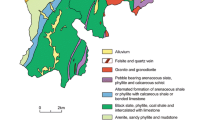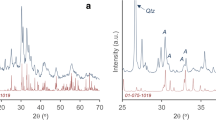Abstract
The effectiveness of silicate- and phosphate-based surface coating agents (Na2SiO3, CaSiO3, and KH2PO4) in inhibiting the oxidation of sulfide minerals in acidic and low temperature conditions was studied. Rock samples were coated using two oxidation methods: H2O2 was mixed with the coating agents in one, whereas in the second, H2O2 was applied to the rock surface prior to the coating agent. The second approach was ineffective, but with Method 1, the pH (5) was above the pH (3.6) of the uncoated control sample. Oxidation, calculated after 14 weeks, had been suppressed by up to 96 and 65%, as indicated by the release of Fe2+ and SO4 2−, respectively. All three coating agents (at concentrations of 0.1 and 0.3 M) suppressed the release of Fe2+ (<3 mg L− 1). Na2SiO3 inhibited Fe2+ and SO4 2− release by 94 and 65%, respectively. Surface protection (or oxidation inhibition) efficiencies of KH2PO4 (in terms of Fe2+ release) were 67, 94, and 96% with 0.05, 0.1, and 0.3 M, respectively. The Na2SiO3 and CaSiO3 coatings, irrespective of their concentrations, reduced iron oxidation by 94 and 84%, respectively. Fourier transform infrared spectroscopy analysis of the Na2SiO3 treated samples showed the presence of iron silicate coatings. Based on this work, coating of rock samples with silicate or phosphate can reduce the oxidation rate of sulfide minerals in acidic and low temperature conditions.
Zusammenfassung
Untersucht wurde die Wirksamkeit von Oberflächenpassivierungschemikalien auf Silikat- und Phosphatbasis (Na2SiO3, CaSiO3, and KH2PO4) in Bezug auf die Hemmung der Oxidation von Sulfidmineralen unter sauren und Niedrigtemperaturbedingungen. Gesteinsproben wurden unter Verwendung zweier Oxidationsmethoden beschichtet: Bei der ersten Methode wurde H2O2 mit den Passivierungschemikalien gemischt, während bei der zweiten Methode die H2O2-Anwendung zeitlich vor der Zugabe des Beschichtungsmittels erfolgte. Während sich die zweite Methode als ineffizient erwies, führte Methode 1 zu einer Anhebung des pH-Wertes (pH=5) im Vergleich zur unbehandelten Probe (pH=3,6). Die nach einem Zeitraum von 14 Wochen berechnete Oxidation wurde um bis zu 96 bzw. 65% verringert, jeweils bezogen auf die Freisetzung von Fe2+ und SO42-. Alle drei Beschichtungsmittel führten in Konzentrationen von 0,1 M und 0,3 M zu einer Unterdrückung der Freisetzung von Fe2+ (<3 mg L-1). Na2SiO3 verringerte die Freisetzung von Fe2+ und SO42- um 94 bzw. 65%. Die Effektivität von KH2PO4 zum Oberflächenschutz bzw. zur Oxidationshemmung betrug unter Heranziehung der Fe2+-Freisetzung 67, 94 und 96%, jeweils bezogen auf die Anwendung von 0,05 M, 0,1 M bzw. 0,3 M Lösungen. Oberflächenbeschichtungen durch Na2SiO3 und CaSiO3 verringerten die Eisenoxidation um 94 bzw. 84%, unabhängig von den verwendeten Konzentrationen. Fourier-Transformations-Infrarot-Spektroskopie-Untersuchungen der mit Na2SiO3 behandelten Proben wiesen das Vorhandensein von Eisensilikat-Überzügen nach. Die Untersuchungen führen zu der Schlussfolgerung, dass die Beschichtung von Gesteinsproben mit Silikat oder Phosphat unter sauren und Niedrigtemperaturbedingungen zu einer Verringerung der Oxidationsrate von Sulfidmineralen führen kann.
Resumen
Se estudió la efectividad de agentes cobertores superficiales basados en fosfato y silicato (Na2SiO3, CaSiO3 y KH2PO4) para inhibir la oxidación de minerales sulfurados en condiciones ácidas y de baja temperatura. Las muestras de roca fueron cubiertas usando dos métodos de oxidación: en el primero, H2O2 fue mezclado con los agentes cobertores y en el segundo, H2O2 fue aplicado sobre la superficie de la roca antes que el agente cobertor. La segunda metodología no fue efectiva, pero con la primera, el pH (5) fue mayor al pH (3.6) de la muestra control sin cubrir. La oxidación, calculada después de 14 semanas, fue reducida en 96 y 65%, indicada por la liberación de Fe2+ y SO42-, respectivamente. Los tres agentes cobertores (a concentraciones de 0,1 y 0,3 M) redujeron la liberación de Fe2+ (<3 mg L-1). Na2SiO3 inhibió la liberación de Fe2+ y SO42- en 94 y 65%, respectivamente. La efectividad de la protección superficial (o la inhibición de la oxidación) de KH2PO4 (en términos de la liberación de Fe2+) fue 67, 94 y 96% para las concentraciones 0,05 M, 0,1 M y 0,3 M, respectivamente. Las coberturas con Na2SiO3 y CaSiO3, independientemente de sus concentraciones, redujeron la oxidación de hierro en 94 y 84%, respectivamente. El análisis por espectroscopía infrarroja por transformada de Fourier de las muestras tratadas con Na2SiO3 mostró la presencia de coberturas de silicatos de hierro. Basados en este trabajo, las coberturas de las muestras de roca con fosfatos y silicatos pueden reducir la velocidad de oxidación de minerales sulfurados en condiciones ácidas y de baja temperatura.
抽象







Similar content being viewed by others
References
Bessho M, Wajima T, Ida T, Nishiyama T (2011) Experimental study on prevention of acid mine drainage by silica coating of pyrite waste rocks with amorphous silica solution. Environ. Earth Sci 64(2):311–318
Cai MF, Dang Z, Chen YW, Belzile N (2005) The passivation of pyrrhotite by surface coating. Chemosphere 61(5):659–667
Chen YW, Li Y, Cai MF, Belzile N, Dang Z (2006) Preventing oxidation of iron sulfide minerals by polyethylene polyamines. Miner Eng 19(1):19–27
Diao Z, Shi T, Wang S, Huang X, Zhang T, Tang Y, Zhang X, Qiu R (2013) Silane-based coatings on the pyrite for remediation of acid mine drainage. Water Res 47(13):4391–4402
Evangelou VP (1995) Potential microencapsulation of pyrite by artificial inducement of ferric phosphate coating. J Environ Qual 24(3):535–542
Evangelou VP (2001) Pyrite microencapsulation technologies: principles and potential field application. Ecol Eng 17(2):165–178
Jha RKT, Satur J, Hiroyoshi N, Ito M, Tsunekawa M (2012) Suppression of pyrite oxidation by carrier microencapsulation using silicon and catechol. Miner Process Extr Metall Rev 33(2):89–98
Ji MK, Gee ED, Yun HS, Lee WR, Park YT, Khan MA, Jeon BH, Choi JY (2012) Inhibition of sulfide mineral oxidation by surface coating agents: batch and field studies. J Hazard Mater 229:298–306
Jiang CL, Wang XH, Parekh BK (2000) Effect of sodium oleate on inhibiting pyrite oxidation. Int J Miner Process 58(1):305–318
Kang CU, Jeon BH, Park SS, Kang JS, Kim KH, Kim DK, Choi UK, Kim SJ (2015) Inhibition of pyrite oxidation by surface coating: a long-term field study. Environ Geochem Health. doi:10.1007/s10653-015-9778-9
Kargbo DM, Chatterjee S (2005) Stability of silicate coatings on pyrite surfaces in a low pH environment. J Environ Eng 131(9):1340–1348
Kargbo DM, Atallah G, Chatterjee S (2004) Inhibition of pyrite oxidation by a phospholipid in the presence of silicate. Environ Sci Technol 38(12):3432–3441
Kollias K, Mylona E, Papassiopi N, Xenidis A (2014) Conditions favoring the formation of iron phosphate coatings on the pyrite surface. Desalination Water Treat 56(5):1–8
Lawrence RW, Wang Y (1997) Determination of neutralization potential in the prediction of acid rock drainage. In: Proceedings of 4th international conference on acid rock drainage (ICARD), Vancouver, pp 15–30
Lawrence RW, Jaffe S, Broughton LM (1988) In-house development of the net acid production test method. Coastech Research Inc, Ottawa
Shamshuddin J, Muhrizal S, Fauziah I, Van Ranst E (2004) A laboratory study of pyrite oxidation in acid sulfate soils. Commun Soil Sci Plant Anal 35(1–2):117–129
Stewart WA, Miller SD, Smart R (2006) Advances in acid rock drainage (ARD) characterization of mine wastes. In: Proceedings of 7th ICARD, St. Louis, MO, USA, pp 2098–2119
Van den Eynde VC, Paradelo R, Monterroso C (2009) Passivation techniques to prevent corrosion of iron sulphides in roofing slates. Corros Sci 51(10):2387–2392
Vempati RK, Loeppert RH (1989) Influence of structure and adsorbed Si on the transformation of synthetic ferrihydrite. Clays Clay Miner 37(3):273–279
Zhang X, Borda MJ, Schoonen MAA, Strongin DR (2003) Pyrite oxidation inhibition by a cross-linked lipid coating. Geochem Trans 4(2):8–11
Acknowledgements
This work was supported by the Mine Reclamation Corporation (MIRECO) and a research Grant (15-09-03-02-06) from the 2015 Research Development Program funded by Ansan Green Environment Center.
Author information
Authors and Affiliations
Corresponding authors
Electronic supplementary material
Below is the link to the electronic supplementary material.
Rights and permissions
About this article
Cite this article
Kang, CU., Jeon, BH., Kumar, R. et al. Stability of Coatings on Sulfide Minerals in Acidic and Low-Temperature Environments. Mine Water Environ 36, 436–442 (2017). https://doi.org/10.1007/s10230-017-0437-5
Received:
Accepted:
Published:
Issue Date:
DOI: https://doi.org/10.1007/s10230-017-0437-5




